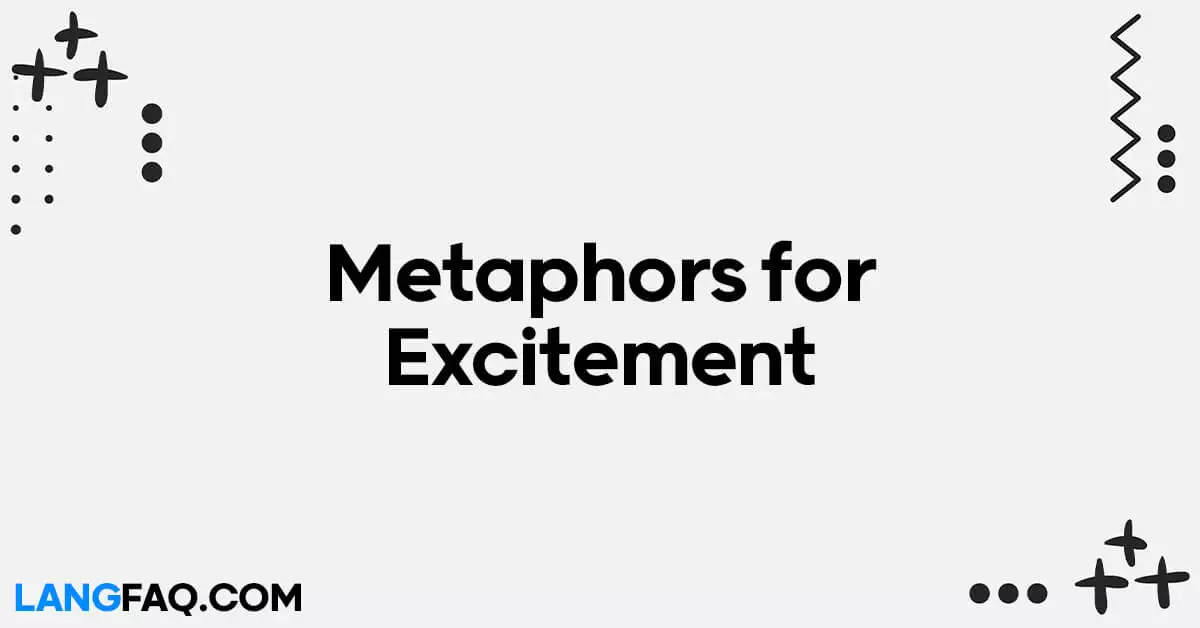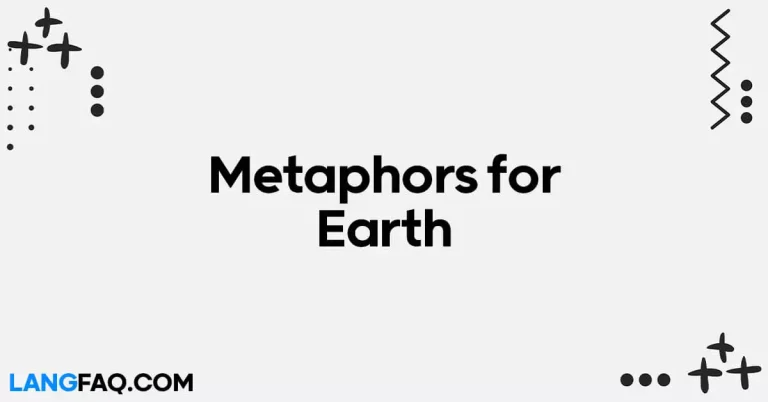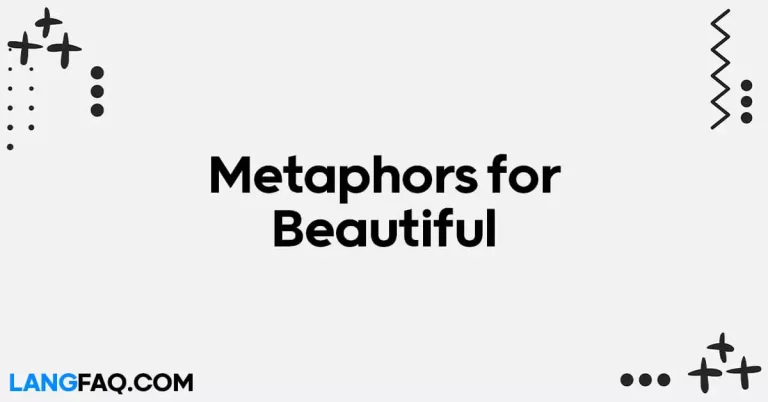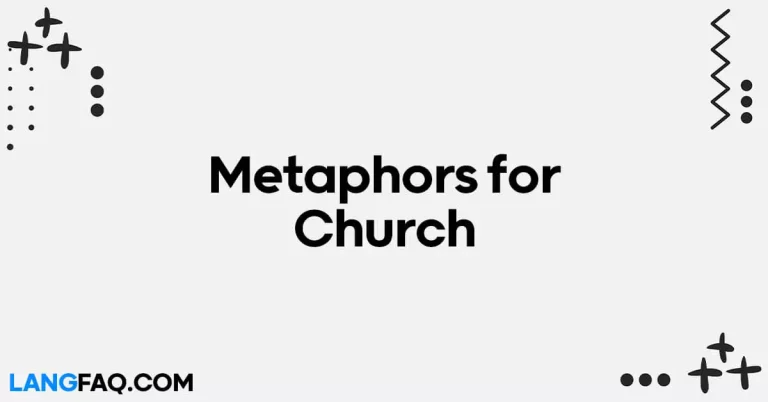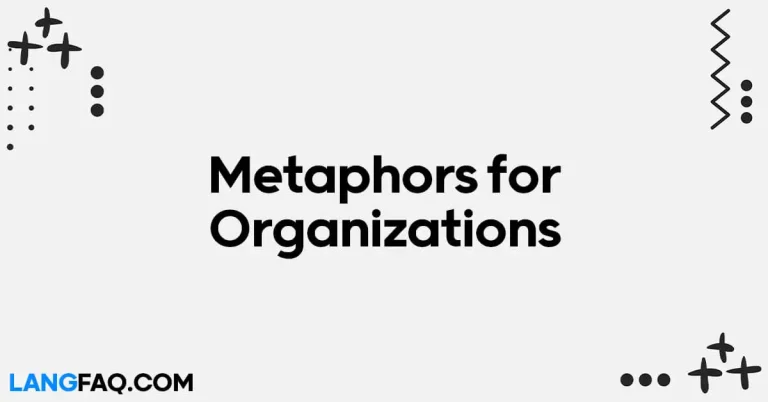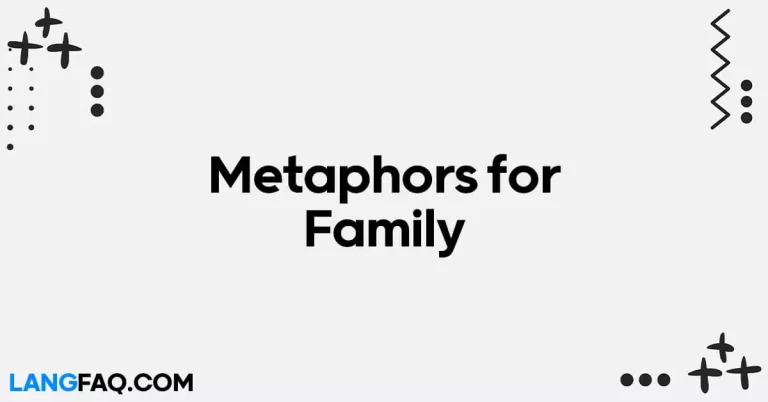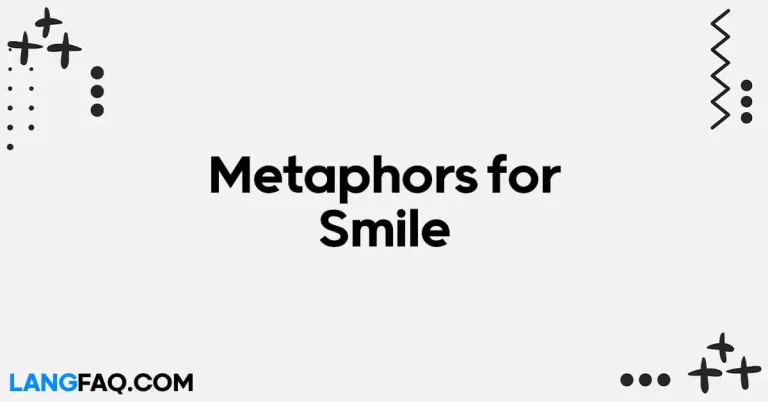Excitement is like a spark igniting in our hearts, a feeling that propels us forward with unbridled energy. It’s the sensation of being on the edge of something wonderful, an emotion that can’t be contained. To capture this fervor in your words, let’s explore 26 metaphors that will help you paint a vibrant picture of excitement in your writing.
26 Metaphors for Excitement
- Fireworks in Your Soul: Excitement is like a grand fireworks display in your soul, lighting up your entire being with joy and anticipation.
- Dancing on Air: When you’re excited, it feels like you’re dancing on air, weightless and carefree.
- Heart-Pounding Symphony: Your heartbeat becomes a symphony, racing with excitement, creating a beautiful melody of anticipation.
- Electric Vibes: Excitement is like electricity coursing through your veins, electrifying your entire being.
- Rollercoaster of Emotions: Life becomes a thrilling rollercoaster ride when excitement takes over, with ups and downs that keep you on the edge of your seat.
- Bubbling Pot of Joy: It’s as if a pot of joy is bubbling inside you, with excitement boiling over like effervescent bubbles.
- Shivers of Anticipation: Excitement sends shivers down your spine, like a gentle, invigorating breeze on a warm summer day.
- Heart in Your Throat: Your heart leaps into your throat, beating rapidly as if it’s trying to catch up with your excitement.
- Eager Beaver: You become as eager as a beaver building a dam, filled with enthusiasm and determination to achieve your goals.
- Like a Kid in a Candy Store: Imagine the excitement of a child in a candy store – wide-eyed, thrilled, and eager to indulge in every sweet possibility.
- Bursting at the Seams: Excitement makes you feel like you’re bursting at the seams, unable to contain the enthusiasm that’s overflowing from within.
- Racing Against the Clock: It’s as if you’re in a race against time, with excitement propelling you forward to achieve your dreams before it’s too late.
- Sparkling Eyes: Your eyes sparkle with excitement, radiating the joy and anticipation bubbling inside you.
- A Butterfly’s Flight: You feel as light and free as a butterfly in flight, with excitement carrying you to new heights.
- Tornado of Thrills: Excitement can be as powerful and unstoppable as a tornado, sweeping you off your feet with its force.
- Beaming Like the Sun: You beam with excitement, your happiness shining as brightly as the sun on a cloudless day.
- Drumroll of Anticipation: Excitement builds like a drumroll, steadily increasing in intensity until it reaches a crescendo of joy.
- Spring in Your Step: With excitement, you have an extra spring in your step, as if you’re walking on air.
- Shooting for the Stars: You aim high and reach for the stars when excitement fuels your ambitions, knowing that the sky’s the limit.
- Heartstrings Melody: Your heart plays a melodious tune of excitement, its strings vibrating with every beat.
- Racing Thoughts: Excitement can set your mind racing, as thoughts and ideas rush in like a torrent.
- Candle in the Wind: It’s like holding a candle in the wind – fragile, yet its flame dances with excitement.
- Thunderstruck: Excitement can strike you like thunder, shaking you to your core with its electrifying presence.
- Ticking Time Bomb: You feel like a ticking time bomb, with excitement counting down to an explosion of joy.
- Light at the End of the Tunnel: Excitement is the light at the end of the tunnel, guiding you through life’s challenges with hope and anticipation.
- Adrenaline Rush: Excitement surges through you like an adrenaline rush, giving you the energy and motivation to conquer anything in your path.
These metaphors offer colorful ways to express the exhilaration and passion that excitement brings to our lives.
| Metaphor | Meaning | Example Sentence |
|---|---|---|
| Fireworks in Your Soul | Excitement lights up your soul like a fireworks display. | “Her face lit up with fireworks in her soul as she received the good news.” |
| Dancing on Air | Feeling weightless and carefree due to excitement. | “After winning the race, he felt like he was dancing on air.” |
| Heart-Pounding Symphony | Your heartbeat becomes an exhilarating melody. | “As the roller coaster plummeted, her heart played a heart-pounding symphony.” |
| Electric Vibes | Excitement electrifies your entire being. | “The electric vibes of the concert had the audience on their feet.” |
| Rollercoaster of Emotions | Life becomes thrilling and unpredictable. | “Experiencing the rollercoaster of emotions during the game kept us engaged.” |
| Bubbling Pot of Joy | Joy bubbles over like a pot on the stove. | “Her laughter was like a bubbling pot of joy, infectious and heartwarming.” |
| Shivers of Anticipation | Excitement sends tingling sensations down your spine. | “The shivers of anticipation before the big reveal were almost unbearable.” |
| Heart in Your Throat | Your heart races and leaps into your throat. | “As she watched the suspenseful movie, her heart was in her throat.” |
| Eager Beaver | Filled with enthusiasm and determination. | “He’s such an eager beaver when it comes to taking on new challenges.” |
| Like a Kid in a Candy Store | Wide-eyed and eager, like a child in a candy shop. | “Exploring the new theme park made her feel like a kid in a candy store.” |
| Bursting at the Seams | Unable to contain the overflowing excitement. | “He couldn’t stop smiling; he felt like he was bursting at the seams.” |
| Racing Against the Clock | Excitement drives you to achieve before time runs out. | “With the deadline approaching, she was racing against the clock to finish the project.” |
| Sparkling Eyes | Eyes radiate joy and anticipation. | “Her sparkling eyes revealed the excitement she felt about the upcoming trip.” |
| A Butterfly’s Flight | Feeling light and free, like a butterfly in the air. | “The news of his promotion gave him a feeling of a butterfly’s flight in his stomach.” |
| Tornado of Thrills | Excitement is powerful and unstoppable like a tornado. | “The Tornado of thrills took over the crowd as the team won the championship.” |
| Beaming Like the Sun | Happiness shines brightly like the sun. | “Her beaming smile was as radiant as the sun on a clear day.” |
| Drumroll of Anticipation | Excitement builds like a drumroll. | “The drumroll of anticipation before the award announcement was deafening.” |
| Spring in Your Step | Having extra energy and enthusiasm in your step. | “With the good news, he had a spring in his step all day.” |
| Shooting for the Stars | Setting high aspirations and aiming for success. | “With her newfound excitement, she was shooting for the stars in her career.” |
| Heartstrings Melody | Your heart plays a beautiful tune of excitement. | “As they met, their hearts played a heartstrings melody of love and joy.” |
| Racing Thoughts | Thoughts and ideas rush in rapidly. | “His racing thoughts generated countless ideas for the project.” |
| Candle in the Wind | Fragile yet dancing with excitement like a candle flame. | “Her hopes were like a candle in the wind, delicate but still burning brightly.” |
| Thunderstruck | Struck by an overwhelming sense of excitement. | “When they announced the surprise party, she was thunderstruck with joy.” |
| Ticking Time Bomb | Feeling like excitement is counting down to an explosion. | “His anticipation was like a ticking time bomb, ready to burst with excitement.” |
| Light at the End of the Tunnel | Excitement guides you through challenges. | “Even in tough times, he always saw the light at the end of the tunnel.” |
| Adrenaline Rush | Excitement surges through you like adrenaline. | “The adrenaline rush of the adventure sport had him craving more.” |
These metaphors provide creative and vivid ways to describe the intense feeling of excitement in various situations and contexts.
Fireworks in Your Soul: A Dazzling Metaphor for Excitement
Definition and Usage: When we say “fireworks in your soul,” we’re describing the sensation of excitement as a breathtaking display of colorful fireworks lighting up the sky. It’s a metaphor that conveys the vividness and intensity of the emotion.
When and Where to Use:
- Informal Conversations: This metaphor works wonderfully in casual conversations with friends and family when describing moments of pure joy.
- Celebratory Events: You can incorporate it into speeches or toasts during celebrations like weddings, birthdays, or anniversaries.
Variations for Different Situations:
- Between Colleagues: “The success of our project felt like a fireworks display in the boardroom.”
- With Friends: “I felt like there were fireworks in my soul when I got accepted into my dream college.”
- In a Mentor-Mentee Context: “Your progress in this project has me witnessing fireworks in my soul with pride.”
Example Sentence: Informal:
- Friend 1: “Guess what? I just won tickets to the concert!”
- Friend 2: “Wow! That’s incredible! You must have had fireworks in your soul when you found out!”
Formal:
- Speaker: “Ladies and gentlemen, as we gather here today to celebrate this beautiful union, let us remember that love has the power to create fireworks in our souls.”
Pros and Cons: Pros:
- Evokes a vivid image of excitement.
- Appeals to the emotions, making it memorable.
- Suitable for various informal occasions.
Cons:
- May not be suitable for very formal settings.
Related Grammar/Usage Rules:
- Use “fireworks in your soul” to express personal excitement.
- Pair with phrases like “I felt like” or “It’s as if” to make comparisons.
Exceptions:
- This metaphor is generally used positively. It may not be suitable for describing negative emotions.
Tips:
- Use it sparingly to maintain its impact.
Dancing on Air: A Light-Hearted Metaphor for Excitement
Definition and Usage: “Dancing on air” is a metaphor that vividly describes the feeling of being extremely excited and light-hearted. It conveys the sense of floating or moving effortlessly due to the exhilaration one experiences.
When and Where to Use:
- Informal Conversations: Use this metaphor with friends and family to describe moments of pure joy and excitement.
- Celebration Events: Incorporate it in speeches or toast during celebratory events like weddings, birthdays, or anniversaries.
Variations for Different Situations:
- Between Colleagues: “We’re dancing on air after hearing about our successful project launch.”
- With Friends: “I was dancing on air when I found out I got accepted into my dream college.”
- In a Mentor-Mentee Context: “Your progress in this project has me dancing on air with pride.”
Example Sentence: Informal:
- Friend 1: “Guess what? I just won tickets to the concert!”
- Friend 2: “Wow! That’s incredible! You must be dancing on air right now!”
Formal:
- Speaker: “Ladies and gentlemen, as we gather here today to celebrate this beautiful union, let us remember that love has the power to make us feel like we’re dancing on air.”
Pros and Cons: Pros:
- Evokes a sense of lightness and joy.
- Appeals to the emotions, making it memorable.
- Suitable for various informal occasions.
Cons:
- May not be suitable for very formal settings.
Related Grammar/Usage Rules:
- Use “dancing on air” to express personal excitement.
- Pair with phrases like “I feel like” or “It’s like” to make comparisons.
Exceptions:
- This metaphor is generally used positively. It may not be suitable for describing negative emotions.
Tips:
- Use it when you want to infuse your language with a lighthearted and carefree feel.
Heart-Pounding Symphony: A Powerful Metaphor for Excitement
Definition and Usage: “Heart-Pounding Symphony” is a metaphor that likens the sensation of excitement to the intricate and exhilarating music of a symphony, with the heartbeat serving as the conductor.
When and Where to Use:
- Formal Speeches: Employ it in formal speeches or presentations to convey intense excitement.
- Creative Writing: Use it in literature or storytelling to add depth to characters’ emotions.
Variations for Different Situations:
- Between Colleagues: “The announcement of our new partnership felt like a heart-pounding symphony in the boardroom.”
- With Friends: “Our road trip had us experiencing a heart-pounding symphony of adventure.”
Example Sentence: Formal:
- Presenter: “Ladies and gentlemen, the launch of our groundbreaking product is not just an event; it’s a heart-pounding symphony of innovation and progress.”
Creative Writing:
- The protagonist’s heart raced, creating a heart-pounding symphony of anticipation as they stood on the brink of discovery.
Pros and Cons: Pros:
- Conveys intensity and depth of excitement.
- Paints a vivid mental image.
- Suitable for formal and creative contexts.
Cons:
- May be considered too dramatic for casual conversations.
Related Grammar/Usage Rules:
- Use “heart-pounding symphony” when describing strong emotions.
- Can be used to add depth to storytelling.
Exceptions:
- This metaphor is versatile and can be adapted to various situations.
Tips:
- Use it when you want to emphasize the intensity of excitement.
Electric Vibes: A Modern Metaphor for Excitement
Definition and Usage: “Electric Vibes” is a contemporary metaphor that likens the sensation of excitement to the energetic and electrifying feeling of electricity coursing through one’s body.
When and Where to Use:
- Casual Conversations: Incorporate it into everyday conversations with friends and peers.
- Social Media: Ideal for expressing excitement in posts or comments.
Variations for Different Situations:
- Between Colleagues: “The team’s enthusiasm gave the office electric vibes during the project presentation.”
- With Friends: “Last night’s concert had the crowd buzzing with electric vibes.”
Example Sentence: Casual:
- Friend 1: “Guess who’s coming to the party tonight?”
- Friend 2: “No way! Electric vibes already!”
Social Media:
- Post: “Just got tickets to my favorite band’s concert! Feeling the electric vibes already! ⚡🎵”
Pros and Cons: Pros:
- Modern and relatable metaphor.
- Easily understood by a diverse audience.
- Perfect for informal settings and online communication.
Cons:
- May lack the depth needed for more formal contexts.
Related Grammar/Usage Rules:
- Use “electric vibes” when describing excitement, especially in contemporary settings.
- Suitable for hashtags and captions on social media.
Exceptions:
- This metaphor is best suited for conveying positive emotions.
Tips:
- Use it when you want to infuse your language with a trendy and energetic feel.
Rollercoaster of Emotions: A Thrilling Metaphor for Excitement
Definition and Usage: The metaphor “Rollercoaster of Emotions” describes excitement as a thrilling, unpredictable ride with ups and downs, much like a rollercoaster. It conveys the idea of a dynamic emotional journey.
When and Where to Use:
- Informal Conversations: Use it when sharing personal experiences of excitement with friends and family.
- Storytelling: Incorporate it into narratives to add suspense and engagement.
Variations for Different Situations:
- Between Colleagues: “The launch of the new product felt like a rollercoaster of emotions in the office.”
- With Friends: “Our trip to the amusement park was a rollercoaster of emotions!”
Example Sentence: Informal:
- Friend 1: “I can’t believe I won the lottery!”
- Friend 2: “Your life is going to be a rollercoaster of emotions from now on!”
Storytelling:
- As the protagonist faced unexpected challenges, their journey became a rollercoaster of emotions, with highs of triumph and lows of despair.
Pros and Cons: Pros:
- Evokes a vivid and relatable image.
- Ideal for storytelling and sharing personal experiences.
- Captures the unpredictability of excitement.
Cons:
- May not be suitable for very formal settings or professional speeches.
Related Grammar/Usage Rules:
- Use “rollercoaster of emotions” to describe the dynamic nature of excitement.
- Effective in creating suspense in narratives.
Exceptions:
- This metaphor is versatile and can be adapted to various situations where emotions are involved.
Tips:
- Employ it when you want to convey the exhilarating and unpredictable nature of excitement.
Bubbling Pot of Joy: A Whimsical Metaphor for Excitement
Definition and Usage: The metaphor “Bubbling Pot of Joy” likens excitement to the image of joy bubbling over like a pot on the stove. It conveys a sense of effervescence and exuberance.
When and Where to Use:
- Informal Conversations: Use it to describe moments of excitement in everyday conversations.
- Expressive Writing: Incorporate it in creative writing to evoke a playful atmosphere.
Variations for Different Situations:
- Between Colleagues: “The team’s reaction to the successful pitch was like a bubbling pot of joy in the conference room.”
- With Friends: “Our surprise party had everyone’s joy bubbling over like a pot of laughter and fun.”
Example Sentence: Informal:
- Friend 1: “You won’t believe what happened today!”
- Friend 2: “Tell me! I can’t wait to hear about your bubbling pot of joy!”
Expressive Writing:
- The festival was a true celebration, with the streets filled with people whose happiness was like a bubbling pot of joy, spilling over into the night.
Pros and Cons: Pros:
- Creates a whimsical and playful image of excitement.
- Ideal for casual conversations and creative expressions.
- Conjures a sense of infectious joy.
Cons:
- May not be suitable for formal or professional contexts.
Related Grammar/Usage Rules:
- Use “bubbling pot of joy” to describe the exuberant nature of excitement.
- Effective in creating a light and cheerful atmosphere in writing.
Exceptions:
- This metaphor is generally used to convey positive emotions and may not be suitable for negative or somber situations.
Tips:
- Utilize it when you want to emphasize the infectious and joyful quality of excitement.
Shivers of Anticipation: A Tantalizing Metaphor for Excitement
Definition and Usage: “Shivers of Anticipation” metaphorically describes excitement as a sensation that sends tingling shivers down your spine. It signifies the thrilling and electrifying aspect of excitement.
When and Where to Use:
- Informal Conversations: Employ it when talking about personal excitement with friends or family.
- Storytelling: Use it in narratives to build anticipation and suspense.
Variations for Different Situations:
- Between Colleagues: “The team’s anticipation before the project’s success announcement sent shivers of excitement through the office.”
- With Friends: “Waiting for the surprise had us all feeling shivers of anticipation!”
Example Sentence: Informal:
- Friend 1: “I have some exciting news to share!”
- Friend 2: “Spill it! I’m feeling shivers of anticipation already!”
Storytelling:
- As the treasure hunters ventured deeper into the mysterious cave, shivers of anticipation coursed through their spines, driven by the thrill of discovery.
Pros and Cons: Pros:
- Evokes a vivid physical sensation of excitement.
- Effective for creating suspense and anticipation.
- Suitable for informal conversations and storytelling.
Cons:
- May not be suitable for very formal or professional contexts.
Related Grammar/Usage Rules:
- Use “shivers of anticipation” to describe the tingling, thrilling aspect of excitement.
- Ideal for building anticipation in narratives.
Exceptions:
- This metaphor is adaptable to various situations where the element of anticipation and excitement is present.
Tips:
- Use it when you want to convey the electrifying and thrilling nature of excitement.
Heart in Your Throat: A Metaphor for Heart-Pounding Excitement
Definition and Usage: “Heart in Your Throat” metaphorically portrays excitement as a sensation where your heart races to the extent that it feels like it has leaped into your throat. It signifies intense and heart-pounding excitement.
When and Where to Use:
- Informal Conversations: Use it when sharing personal experiences of excitement with friends or family.
- Expressive Writing: Incorporate it in narratives or descriptions to convey the intensity of excitement.
Variations for Different Situations:
- Between Colleagues: “The high-stakes presentation had our hearts in our throats as we awaited the client’s response.”
- With Friends: “When they announced the surprise party, our hearts were in our throats with excitement.”
Example Sentence: Informal:
- Friend 1: “Guess what? I just won the competition!”
- Friend 2: “No way! Your heart must have been in your throat when they announced the winner!”
Expressive Writing:
- As the protagonist faced the dramatic climax of the story, their heart was in their throat, pounding with the exhilaration of the moment.
Pros and Cons: Pros:
- Evokes a powerful physical sensation of excitement.
- Ideal for conveying intense emotions and experiences.
- Suitable for informal conversations and dramatic descriptions.
Cons:
- May not be suitable for very formal or professional contexts.
Related Grammar/Usage Rules:
- Use “heart in your throat” to describe the intense, heart-pounding nature of excitement.
- Effective in creating suspense and intensity in writing.
Exceptions:
- This metaphor is versatile and can be adapted to various situations where intense excitement is present.
Tips:
- Utilize it when you want to emphasize the heart-racing and intense aspect of excitement.
Eager Beaver: A Enthusiastic Metaphor for Excitement
Definition and Usage: The metaphor “Eager Beaver” describes excitement as a state of enthusiasm and determination, much like a diligent beaver working tirelessly. It signifies a readiness to dive into action.
When and Where to Use:
- Informal Conversations: Utilize it to express eagerness and enthusiasm in everyday conversations.
- Workplace Enthusiasm: Appropriate for talking about enthusiasm in professional contexts when it’s informal.
Variations for Different Situations:
- Between Colleagues: “The team was like a bunch of eager beavers, ready to tackle the challenging project head-on.”
- With Friends: “I’m such an eager beaver when it comes to planning our annual camping trip.”
Example Sentence: Informal:
- Friend 1: “Are you excited about the upcoming adventure?”
- Friend 2: “Absolutely! I’m an eager beaver, already planning every detail!”
Professional Context:
- Colleague 1: “We have a tight deadline for the proposal.”
- Colleague 2: “Don’t worry, we’ll approach it like eager beavers and get it done.”
Pros and Cons: Pros:
- Conveys enthusiasm and readiness for action.
- Easily relatable in both casual and professional conversations.
- Encourages a positive and proactive image.
Cons:
- May not be suitable for extremely formal settings.
Related Grammar/Usage Rules:
- Use “eager beaver” to describe the enthusiastic and proactive nature of excitement.
- Suitable for emphasizing enthusiasm in various contexts.
Exceptions:
- This metaphor is generally used positively to convey enthusiasm. It may not be suitable for describing negative emotions.
Tips:
- Employ it when you want to emphasize the proactive and enthusiastic aspect of excitement.
Like a Kid in a Candy Store: A Nostalgic Metaphor for Excitement
Definition and Usage: “Like a Kid in a Candy Store” metaphorically compares excitement to the sensation of being in a candy store as a child – wide-eyed, thrilled, and eager to indulge in every sweet possibility. It signifies unbridled enthusiasm.
When and Where to Use:
- Informal Conversations: Use it to express uncontainable excitement and enthusiasm with friends and family.
- Descriptive Writing: Incorporate it in narratives or descriptions to evoke a sense of nostalgia and delight.
Variations for Different Situations:
- Between Colleagues: “The new product launch had everyone in the office feeling like kids in a candy store.”
- With Friends: “Exploring the new theme park made us feel like kids in a candy store.”
Example Sentence: Informal:
- Friend 1: “Guess what? I just got tickets to the concert!”
- Friend 2: “No way! You must have felt like a kid in a candy store when you got them!”
Descriptive Writing:
- The marketplace buzzed with activity, and the shoppers moved from stall to stall with wide eyes, like kids in a candy store, eager to savor every delightful sight.
Pros and Cons: Pros:
- Evokes a vivid and relatable image of boundless enthusiasm.
- Ideal for casual conversations and descriptive writing.
- Creates a sense of nostalgia and delight.
Cons:
- May not be suitable for very formal or professional contexts.
Related Grammar/Usage Rules:
- Use “like a kid in a candy store” to describe uncontainable and childlike excitement.
- Effective in creating a sense of wonder and enthusiasm in writing.
Exceptions:
- This metaphor is generally used positively to convey unbridled enthusiasm and delight. It may not be suitable for describing negative emotions.
Tips:
- Utilize it when you want to emphasize the childlike wonder and uncontainable joy of excitement.
Bursting at the Seams: A Metaphor for Overflowing Excitement
Definition and Usage: “Bursting at the Seams” metaphorically represents excitement as a sensation where emotions are so intense that they feel like they are about to burst through one’s constraints. It signifies an overwhelming, almost uncontrollable feeling.
When and Where to Use:
- Informal Conversations: Utilize it to express intense excitement in everyday conversations with friends and family.
- Expressive Writing: Incorporate it in narratives or descriptions to emphasize the uncontrollable nature of excitement.
Variations for Different Situations:
- Between Colleagues: “The team’s enthusiasm for the project was so intense; it was like we were bursting at the seams.”
- With Friends: “When they announced the surprise party, we were all bursting at the seams with anticipation!”
Example Sentence: Informal:
- Friend 1: “I can’t hold it in any longer—I got the job!”
- Friend 2: “I knew it! You must be bursting at the seams right now!”
Expressive Writing:
- As the main character finally met their long-lost friend, they felt emotions so strong that they were bursting at the seams, unable to contain their joy.
Pros and Cons: Pros:
- Conveys intense, overwhelming excitement.
- Ideal for describing emotions that are difficult to contain.
- Effective in both casual conversations and expressive writing.
Cons:
- May not be suitable for extremely formal settings.
Related Grammar/Usage Rules:
- Use “bursting at the seams” to describe the overwhelming and uncontrollable aspect of excitement.
- Effective in creating a sense of intensity and emotional release in writing.
Exceptions:
- This metaphor is adaptable to various situations where excitement becomes almost too much to handle.
Tips:
- Employ it when you want to emphasize the intensity and uncontrollable nature of excitement.
Racing Against the Clock: A Metaphor for Time-Critical Excitement
Definition and Usage: “Racing Against the Clock” metaphorically likens excitement to a situation where time is running out, and one must act quickly. It signifies a sense of urgency and the thrill of beating a deadline.
When and Where to Use:
- Informal Conversations: Use it to describe moments of excitement when time is of the essence.
- Work or Academic Contexts: Appropriate for discussing the rush of completing tasks under time pressure.
Variations for Different Situations:
- Between Colleagues: “The last-minute presentation had us all racing against the clock, but the excitement kept us going.”
- With Friends: “Preparing for the surprise anniversary party was a rush, like racing against the clock.”
Example Sentence: Informal:
- Friend 1: “We have to catch the flight in 30 minutes!”
- Friend 2: “I love this kind of excitement—like racing against the clock!”
Work Context:
- Colleague 1: “We need this report by the end of the day.”
- Colleague 2: “No problem, I thrive on racing against the clock!”
Pros and Cons: Pros:
- Conveys excitement related to time-sensitive situations.
- Ideal for describing the thrill of meeting deadlines.
- Suitable for both casual conversations and professional contexts.
Cons:
- May not be suitable for very formal or somber settings.
Related Grammar/Usage Rules:
- Use “racing against the clock” to describe excitement related to time constraints.
- Effective in conveying a sense of urgency and time pressure.
Exceptions:
- This metaphor is generally used in positive contexts where meeting a deadline is exciting.
Tips:
- Utilize it when you want to emphasize the rush and exhilaration of time-critical excitement.
Spark in Your Step: A Energetic Metaphor for Excitement
Definition and Usage: “Spark in Your Step” metaphorically compares excitement to an energetic spark that invigorates your actions and movements. It signifies an infusion of energy and enthusiasm.
When and Where to Use:
- Informal Conversations: Employ it to express enthusiasm and energy in everyday conversations.
- Positive Self-Talk: Use it as a motivational phrase to boost your own enthusiasm.
Variations for Different Situations:
- Between Colleagues: “Our team’s excitement brought a spark in our step during the project presentation.”
- With Friends: “Exploring the new city had us all with a spark in our step.”
Example Sentence: Informal:
- Friend 1: “Ready for the adventure of a lifetime?”
- Friend 2: “Absolutely! I’ve got a spark in my step just thinking about it!”
Positive Self-Talk:
- “Today, I’m going to tackle my goals with a spark in my step and boundless enthusiasm!”
Pros and Cons: Pros:
- Conveys a sense of energy and vitality.
- Ideal for expressing enthusiasm in everyday conversations.
- Encourages a positive and proactive mindset.
Cons:
- May not be suitable for very formal settings.
Related Grammar/Usage Rules:
- Use “spark in your step” to describe the energetic and enthusiastic aspect of excitement.
- Effective for self-motivation and encouraging a proactive attitude.
Exceptions:
- This metaphor is generally used positively to convey enthusiasm. It may not be suitable for describing negative emotions.
Tips:
- Employ it when you want to emphasize the infusion of energy and enthusiasm that comes with excitement.
Radiating Sunshine: A Metaphor for Joyful Excitement
Definition and Usage: “Radiating Sunshine” metaphorically portrays excitement as a state where one’s joy and positivity shine brightly, much like the warming rays of the sun. It signifies a joyful and optimistic form of excitement.
When and Where to Use:
- Informal Conversations: Utilize it to express joyful and positive excitement with friends and family.
- Descriptive Writing: Incorporate it in narratives or descriptions to create an atmosphere of happiness.
Variations for Different Situations:
- Between Colleagues: “The team’s reaction to the good news was like radiating sunshine in the office.”
- With Friends: “Our reunion filled the room with radiating sunshine.”
Example Sentence: Informal:
- Friend 1: “I have incredible news to share!”
- Friend 2: “Your face is already radiating sunshine! Tell me!”
Descriptive Writing:
- As the protagonist achieved their lifelong dream, their heart felt like it was radiating sunshine, warming everyone around them with their joy.
Pros and Cons: Pros:
- Conveys a sense of joy and positivity.
- Ideal for expressing happiness and optimism in everyday conversations.
- Creates a warm and cheerful atmosphere.
Cons:
- May not be suitable for very formal or professional contexts.
Related Grammar/Usage Rules:
- Use “radiating sunshine” to describe the joyful and optimistic aspect of excitement.
- Effective in creating a positive and uplifting atmosphere in writing.
Exceptions:
- This metaphor is generally used to convey positive emotions and may not be suitable for describing negative feelings.
Tips:
- Utilize it when you want to emphasize the joy and positivity that accompany excitement.
Thrill in Your Veins: A Metaphor for Exhilarating Excitement
Definition and Usage: “Thrill in Your Veins” metaphorically describes excitement as a sensation where you can feel the thrill coursing through your veins like a surge of energy. It signifies an exhilarating and invigorating form of excitement.
When and Where to Use:
- Informal Conversations: Employ it to express a heightened sense of excitement in everyday conversations.
- Expressive Writing: Use it in narratives or descriptions to convey the invigorating aspect of excitement.
Variations for Different Situations:
- Between Colleagues: “The announcement of our success had the thrill in our veins, making us ready for the next challenge.”
- With Friends: “Our adventure trip had the thrill in our veins, making it an unforgettable experience.”
Example Sentence: Informal:
- Friend 1: “I can’t believe we’re going skydiving!”
- Friend 2: “I know, right? I can already feel the thrill in my veins!”
Expressive Writing:
- As the racecar sped around the track, the driver could feel the thrill in their veins, pushing them to the limits of their abilities.
Pros and Cons: Pros:
- Conveys a sense of exhilaration and invigoration.
- Ideal for describing intense and thrilling excitement.
- Effective in both casual conversations and expressive writing.
Cons:
- May not be suitable for very formal settings.
Related Grammar/Usage Rules:
- Use “thrill in your veins” to describe the invigorating and exhilarating aspect of excitement.
- Effective for creating a sense of high-energy and exhilaration in writing.
Exceptions:
- This metaphor is versatile and can be adapted to various situations where excitement is particularly intense.
Tips:
- Employ it when you want to emphasize the electrifying and invigorating nature of excitement.
Butterfly Effect: A Metaphor for Nervous Excitement
Definition and Usage: “Butterfly Effect” metaphorically likens excitement to the fluttering and nervous sensation in one’s stomach, similar to the way butterflies create a fluttering effect when in motion. It signifies a form of excitement mixed with nervousness or anticipation.
When and Where to Use:
- Informal Conversations: Utilize it to describe moments of nervous or anticipatory excitement in everyday conversations.
- Personal Reflection: Use it for self-expression when discussing your own feelings.
Variations for Different Situations:
- Between Colleagues: “Before the big presentation, I felt the butterfly effect in my stomach.”
- With Friends: “Meeting my crush had me experiencing the butterfly effect.”
Example Sentence: Informal:
- Friend 1: “You’ve got a big interview tomorrow, right?”
- Friend 2: “Yeah, I can already feel the butterfly effect kicking in.”
Personal Reflection:
- Facing the audience for the first time, the speaker couldn’t help but feel the butterfly effect in their stomach, a mix of excitement and nervousness.
Pros and Cons: Pros:
- Conveys a sense of nervous or anticipatory excitement.
- Ideal for describing mixed emotions related to excitement.
- Effective in both casual conversations and self-expression.
Cons:
- May not be suitable for very formal settings.
Related Grammar/Usage Rules:
- Use “butterfly effect” to describe the nervous or anticipatory aspect of excitement.
- Effective for conveying mixed emotions and anticipation in writing.
Exceptions:
- This metaphor is generally used when there is a mix of excitement and nervousness, not for purely positive excitement.
Tips:
- Utilize it when you want to emphasize the mixed emotions and anticipation that accompany excitement.
Fireworks of Enthusiasm: A Spectacular Metaphor for Excitement
Definition and Usage: “Fireworks of Enthusiasm” metaphorically represents excitement as a breathtaking display of fireworks in the sky. It signifies a spectacular and vibrant form of excitement.
When and Where to Use:
- Informal Conversations: Employ it to express enthusiasm and excitement in everyday conversations.
- Expressive Writing: Use it in narratives or descriptions to create a vivid and dazzling image.
Variations for Different Situations:
- Between Colleagues: “The team’s reaction to the project’s success was like fireworks of enthusiasm, lighting up the office.”
- With Friends: “The concert was so incredible; it felt like fireworks of enthusiasm in the crowd!”
Example Sentence: Informal:
- Friend 1: “Guess what? We’re going on a road trip!”
- Friend 2: “That’s amazing news! I can already imagine the fireworks of enthusiasm!”
Expressive Writing:
- As the clock struck midnight, the sky erupted with fireworks of enthusiasm, painting the night with bursts of color and joy.
Pros and Cons: Pros:
- Conveys a sense of spectacular and vibrant excitement.
- Ideal for describing intense and visually stunning excitement.
- Effective in both casual conversations and expressive writing.
Cons:
- May not be suitable for very formal settings.
Related Grammar/Usage Rules:
- Use “fireworks of enthusiasm” to describe the spectacular and visually stunning aspect of excitement.
- Effective for creating a sense of awe and spectacle in writing.
Exceptions:
- This metaphor is adaptable to various situations where excitement is particularly intense and visually striking.
Tips:
- Employ it when you want to emphasize the spectacular and visually dazzling nature of excitement.
Sparkling Eyes and Beaming Smiles: A Metaphor for Radiant Excitement
Definition and Usage: “Sparkling Eyes and Beaming Smiles” metaphorically describes excitement as a state where one’s eyes sparkle with delight, and their smile radiates happiness. It signifies a radiant and joyful form of excitement.
When and Where to Use:
- Informal Conversations: Utilize it to express radiant excitement and happiness in everyday conversations.
- Descriptive Writing: Incorporate it in narratives or descriptions to create a heartwarming atmosphere.
Variations for Different Situations:
- Between Colleagues: “The team’s reaction to the good news was evident in their sparkling eyes and beaming smiles.”
- With Friends: “The surprise party had everyone with sparkling eyes and beaming smiles.”
Example Sentence: Informal:
- Friend 1: “I can’t wait to tell you something wonderful!”
- Friend 2: “Your sparkling eyes and beaming smile tell me it’s exciting news!”
Descriptive Writing:
- As the children opened their presents on Christmas morning, the room was filled with sparkling eyes and beaming smiles, reflecting the joy of the season.
Pros and Cons: Pros:
- Conveys a sense of radiant and heartwarming excitement.
- Ideal for expressing pure happiness and delight in everyday conversations.
- Creates a warm and joyful atmosphere.
Cons:
- May not be suitable for very formal or professional contexts.
Related Grammar/Usage Rules:
- Use “sparkling eyes and beaming smiles” to describe the radiant and joyful aspect of excitement.
- Effective for creating a heartwarming and cheerful atmosphere in writing.
Exceptions:
- This metaphor is generally used to convey positive emotions and may not be suitable for describing negative feelings.
Tips:
- Utilize it when you want to emphasize the radiant and joyful nature of excitement.
Electric Atmosphere: A Charged Metaphor for Excitement
Definition and Usage: “Electric Atmosphere” metaphorically describes excitement as an atmosphere charged with energy and anticipation, much like electricity. It signifies an electrifying and charged form of excitement.
When and Where to Use:
- Informal Conversations: Employ it to express electrifying excitement in everyday conversations.
- Descriptive Writing: Use it in narratives or descriptions to create a dynamic and charged atmosphere.
Variations for Different Situations:
- Between Colleagues: “The stadium had an electric atmosphere as the home team scored the winning goal.”
- With Friends: “Our night out was amazing; the club had an electric atmosphere!”
Example Sentence: Informal:
- Friend 1: “Have you ever been to a live concert?”
- Friend 2: “Yes, and the moment the band started playing, there was an electric atmosphere in the air!”
Descriptive Writing:
- As the suspense built in the courtroom, an electric atmosphere filled the room, with everyone on edge.
Pros and Cons: Pros:
- Conveys a sense of electrifying and charged excitement.
- Ideal for describing intense and dynamic emotions.
- Effective in both casual conversations and expressive writing.
Cons:
- May not be suitable for very formal settings.
Related Grammar/Usage Rules:
- Use “electric atmosphere” to describe the charged and dynamic aspect of excitement.
- Effective for creating a sense of anticipation and energy in writing.
Exceptions:
- This metaphor is versatile and can be adapted to various situations where excitement is particularly dynamic and charged.
Tips:
- Employ it when you want to emphasize the electrifying and charged nature of excitement.
Pounding Heartbeats: A Metaphor for Heartfelt Excitement
Definition and Usage: “Pounding Heartbeats” metaphorically represents excitement as a sensation where one’s heart beats rapidly and strongly, like a drum. It signifies a heartfelt and emotionally charged form of excitement.
When and Where to Use:
- Informal Conversations: Utilize it to express heartfelt excitement in everyday conversations.
- Expressive Writing: Incorporate it in narratives or descriptions to convey the emotional intensity of excitement.
Variations for Different Situations:
- Between Colleagues: “The team’s dedication to the cause brought pounding heartbeats of excitement.”
- With Friends: “Reuniting with old friends always leads to pounding heartbeats of joy.”
Example Sentence: Informal:
- Friend 1: “I have the best news ever!”
- Friend 2: “Your pounding heartbeats are giving it away—tell me!”
Expressive Writing:
- As the lovers finally met after years apart, their pounding heartbeats echoed the intensity of their emotions.
Pros and Cons: Pros:
- Conveys a sense of heartfelt and emotionally charged excitement.
- Ideal for expressing deep and passionate emotions in everyday conversations.
- Creates an emotionally charged atmosphere.
Cons:
- May not be suitable for very formal or professional contexts.
Related Grammar/Usage Rules:
- Use “pounding heartbeats” to describe the heartfelt and emotionally charged aspect of excitement.
- Effective for conveying emotional intensity and passion in writing.
Exceptions:
- This metaphor is generally used to convey positive emotions and may not be suitable for describing negative feelings.
Tips:
- Utilize it when you want to emphasize the emotional intensity and heartfelt nature of excitement.
FAQs
Q: Can I use these metaphors in everyday conversation? A: Absolutely! These metaphors add color and depth to your language, making your conversations more engaging.
Q: Are there other metaphors for excitement besides these? A: Certainly! Metaphors are limitless, so feel free to create your own and tailor them to your experiences.
Q: How can I incorporate these metaphors into my writing? A: Start by identifying the emotion you want to convey, and then choose the metaphor that best captures it. Integrate it seamlessly into your text.
Q: Are metaphors essential for good writing? A: While not essential, metaphors can elevate your writing by making it more vivid and relatable.
Q: Can I use these metaphors in professional contexts? A: Absolutely! Metaphors can add depth to your professional communication, making your ideas more memorable.
Q: Where can I find more resources on using metaphors effectively? A: There are many books and online courses dedicated to improving your metaphorical language skills. Explore these to enhance your writing.
Conclusion
Excitement is a powerful force that infuses our lives with energy and enthusiasm. By incorporating these 26 metaphors into your writing and speech, you can express the beauty and intensity of this emotion like never before. So, go ahead and let your words sparkle with excitement!

